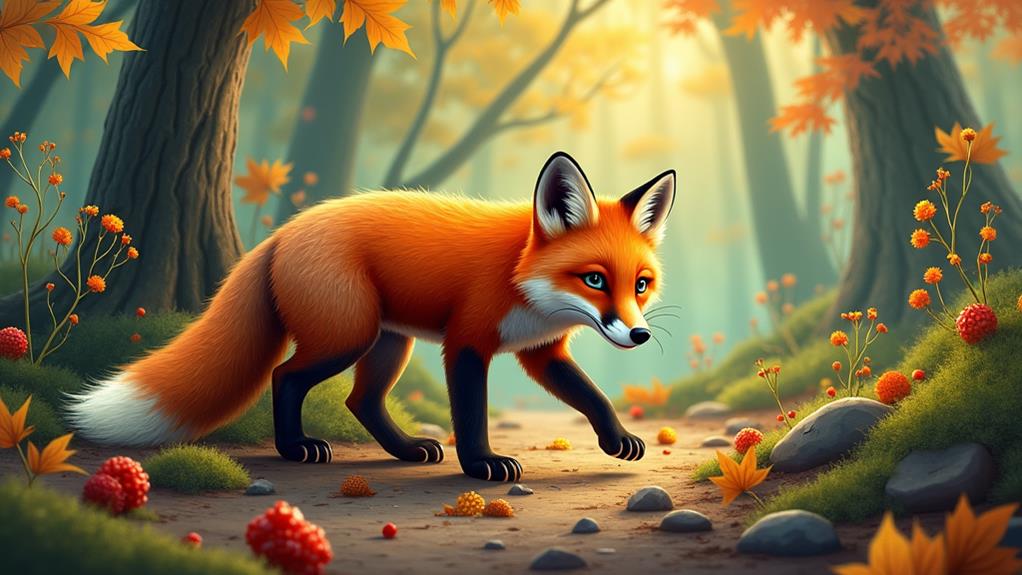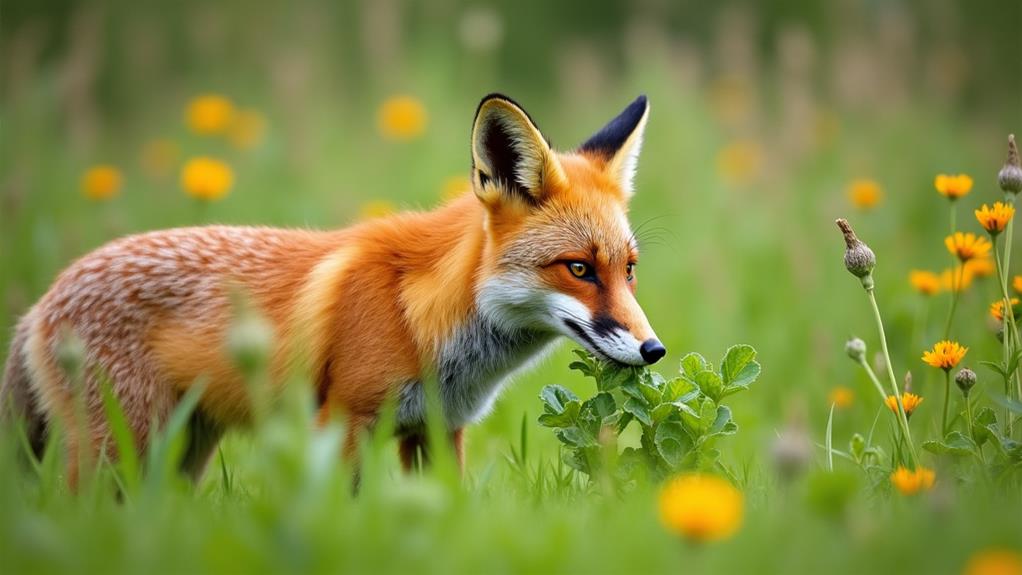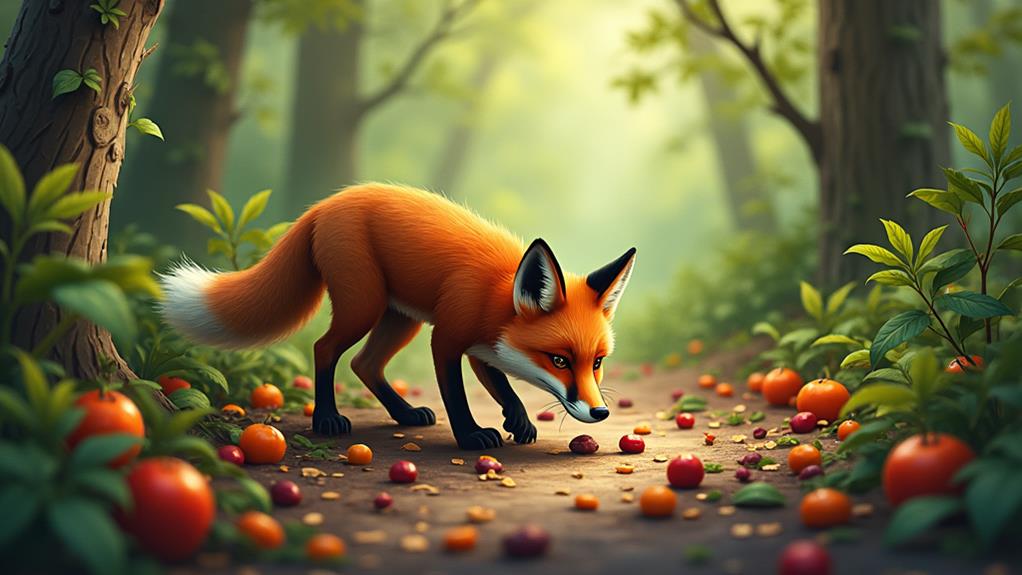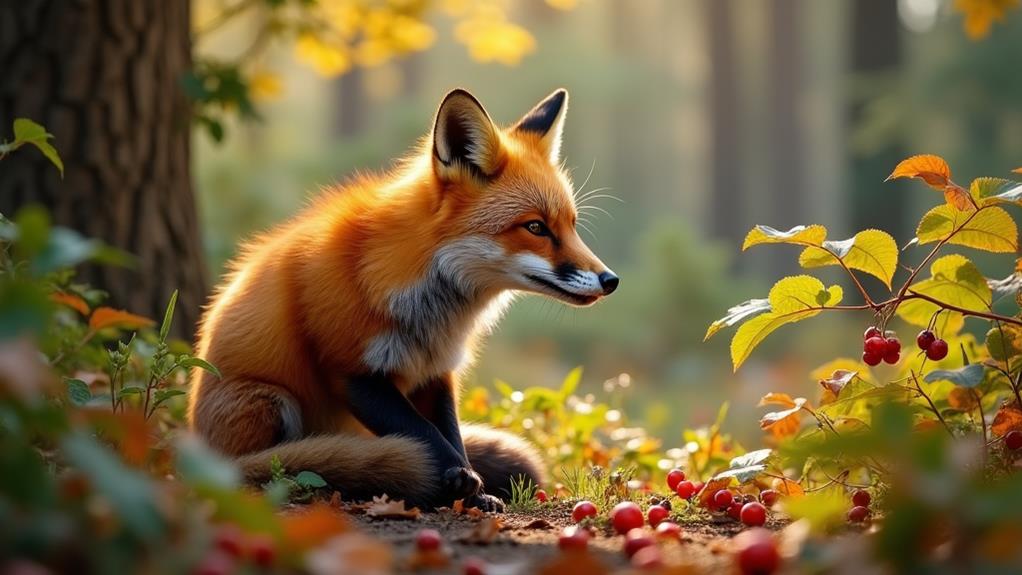Red foxes aren't just about chasing mice; they've got quite the diverse diet! Sure, small mammals like voles are their main dish, but they also munch on berries, bugs, and even carrion when times get tough. These crafty critters adapt their meals based on the season—berries galore in fall and a taste for birds and eggs in spring. They're omnivores, not herbivores, and this flexibility helps them thrive in various environments. So, if you think red foxes are just rodent connoisseurs, think again! Stick around, and you'll uncover even more about their fascinating food habits.
Contents
Overview of Red Fox Diet

When it comes to their diet, red foxes are remarkably versatile. Their culinary tastes can surprise you! The Red Fox Diet features a variety of food sources, highlighting just how adaptable these clever critters really are.
They particularly love small mammals like bank voles and field voles, which serve as their main course. In diverse habitats like forests and grasslands, they can easily find these prey animals, demonstrating their keen hunting skills. If you think about it, they're like nature's little pest controllers!
Now, seasonal dietary variations play a big role too. In summer, when everything's blooming, red foxes indulge in insects and fruits, especially tasty berries. That's right, they've got a sweet tooth for blackberries and raspberries!
Come winter, they switch gears, munching more on small mammals and carrion. Talk about a well-rounded diet!
Believe it or not, a red fox typically consumes around 350g to 550g of food daily. They know how to feast when they need to, all while staying attuned to the changing environment around them.
Common Foods Consumed
When you think about red foxes, picture them stalking small mammals like voles and mice, which make up a big part of their diet.
Their flexible, omnivorous diet illustrates resourcefulness, allowing them to adapt based on seasonal food availability.
But don't forget that they also flex their culinary skills with seasonal treats like berries and even scavenged hedgehogs when winter rolls around.
It's fascinating how these clever creatures adapt their eating habits to what's available, sprinkling a bit of variety into their menu!
Small Mammals Preference
Red foxes have a strong preference for small mammals, which makes up a significant portion of their diet. You'll often find these cunning creatures hunting bank voles and field voles, as they're the most frequently targeted prey species.
In urban settings, don't be surprised if you spot foxes nabbing mice and brown rats. It's pretty amusing to think that young cubs practice their hunting skills on these rats, giving them a leg up on their prey drive. Their adaptability allows them to thrive in various environments, demonstrating their remarkable versatility as hunters in both rural and urban habitats, which can be observed in their diverse ecosystems and adaptation.
Research by David Macdonald shows that captive vixens have a marked fondness for field voles, highlighting how crucial this little critter is in their diet. When vole populations soar, foxes can gulp down more than 40 in a single meal!
It's a real feast, proving that in the world of red foxes, the little guys play a big role. Sometimes, they may munch on rarer species like shrews and moles, but generally, these don't stick around for long—apparently, they're not the tastiest treats.
Seasonal Dietary Changes
As seasons change, so do the dietary habits of red foxes. These clever critters adjust their food choices, depending on what's available. In spring and early summer, when cubs are demanding more nutrition, you'll notice an uptick in bird consumption. It's a mealtime frenzy to guarantee their little ones grow strong and healthy!
As summer turns to fall, foxes eat more fruits like blackberries and raspberries. Imagine them rummaging through hedgerows with their little noses wiggling in delight. It's estimated that around 76% of fox stomachs contain fruit remains during autumn!
Just when you think you've seen it all, during late summer, invertebrates like earthworms become essential, supporting over 60% of nutrition needed for cub survival.
Winter brings a new twist, where these crafty foxes start scavenging more. In harsh conditions, about 13% of their diet can come from hedgehogs! This showcases their adaptability and ability to thrive through seasonal dietary changes, highlighting the diverse prey species they consume.
Red foxes don't just survive—they make it through, one meal at a time!
Importance of Berries
Berries play an essential role in the diet of foxes, especially during autumn when they're most plentiful. You might be surprised to learn how much these furry creatures love their fruity treats! Red foxes enthusiastically snack on blackberries, blueberries, and raspberries when they're ripe, making berries an important food source.
Curiously, a study in Denmark found that 76% of fox stomachs contained fruit remnants, revealing that berries aren't just a side dish—they're a significant part of the fox diet.
During late summer and autumn, you'll see these clever foxes consuming berries more than ever, showcasing their seasonal dietary adaptations. When small mammals become scarce, berries help them stay energized, proving that foxes can live healthfully even when their usual meals are hard to find.
What's even more fascinating is how resourceful foxes can be! They'll climb trees or bushes to reach those succulent berries, reminding us all to adapt when faced with challenges.
Seasonal Dietary Changes

When the seasons shift, so do the dietary habits of foxes, reflecting the changes in food availability. These clever creatures are much like us when it comes to their craving for variety.
In spring and summer, small mammals, particularly voles, become the star of the show, and you can bet that foxes are making the most of this buffet. As summer gives way to autumn, they swap their menu for fruits and invertebrates. Just picture a fox snacking on juicy berries or crunching down on tasty insects!
When winter rolls in, though, things get a bit tougher. Foxes adapt by munching on hedgehogs—yes, those adorable, spiky little creatures! Hedgehogs can make up a surprising 13% of their winter diet during frigid months. Talk about a seasonal shift!
These seasonal dietary changes not only showcase the fox's resourcefulness but also allude to the beauty of nature's rhythm. It teaches us to appreciate the ingredients we've around us, adjusting to what's in season.
Role of Invertebrates
Have you ever thought about what makes up a red fox's diet?
Surprisingly, invertebrates like beetles and earthworms can provide a whopping 30% of their meals, especially in desert areas where these critters are plentiful.
During late summer and autumn, foxes really ramp up their consumption of these tasty treats, showing just how adaptable they can be when it comes to finding food.
Invertebrate Nutritional Contribution
Invertebrates play an essential role in the dietary habits of red foxes, particularly in desert habitats where they can make up to 30% of their diet.
Imagine a world where these clever creatures harness the power of beetles, grasshoppers, and snails as crucial food sources. It's quite impressive! These invertebrates deliver essential nutrition, boosting the fox's overall health and enhancing their dietary breadth.
Now, let's spotlight earthworms! During certain months, especially when earthworms are plentiful, they can account for over 60% of the diet for fox cubs.
This whopping percentage shows how critical these squiggly critters are for the little ones' survival. It's like a buffet for them!
Foxes display remarkable adaptability by employing specialized hunting techniques to target these tasty earthworms.
This resourcefulness not only showcases their skills but also emphasizes the significance of invertebrates in their habitats.
Seasonal Consumption Patterns
How do seasonal changes impact the dietary choices of red foxes? Well, these clever canines adapt their diet based on what's available, and invertebrates play a key role in that mix. In fact, they can make up to 30% of a fox's diet, especially during late summer and autumn when invertebrate populations thrive.
Here are some things to contemplate about their seasonal invertebrate consumption:
- Earthworms can be vital for cub survival, sometimes accounting for over 60% of their diet during lean months.
- Specialized hunting techniques help foxes snag earthworms, showcasing their adaptability.
- Many invertebrates, like beetles and grasshoppers, become staples when mammals are hard to find.
- Changing environmental conditions influence availability, leading to flexible eating habits.
- This opportunistic feeding helps guarantee they get the nutrients they need throughout the year.
Plant Material in Diet

What role do plant materials play in the diet of red foxes? Well, they actually play a pretty significant part! Red foxes aren't just hunters; they're opportunistic feeders, and their love for plant material, especially fruits like blackberries, blueberries, and raspberries, really shows this.
In fact, a Danish study found that 76% of examined fox stomachs contained fruit remains! Isn't that fascinating?
During autumn, when these delicious fruits are plentiful, red foxes make the most of them. Not only does munching on these treats add variety to their dietary habits, but it also provides important nutrients like vitamin C. Talk about a nutritious snack!
But that's not all. They don't shy away from cultivated crops either, like corn and barley.
These adaptations allow red foxes to thrive, especially in seasons when their usual animal prey isn't as available. So, next time you see a red fox, know that they're not just about chasing down dinner; they're also foraging for those sweet, tasty fruits, proving adaptability is key in their survival!
Predation on Birds and Eggs
During the spring and early summer, red foxes ramp up their predation on birds and eggs, driven by the need to nourish their growing cubs.
With cubs demanding more food, foxes become skilled hunters, often targeting nests of unsuspecting birds. You might find it interesting that approximately 70% of analyzed fox scat in forest areas contains bird remains. This shows just how much these clever creatures adapt their diets during the cub-rearing season.
- Foxes primarily consume gamebirds, like quail and pheasants.
- They exhibit effective nest raiding rates of up to 96%.
- Adverse weather often makes nesting birds more vulnerable.
- Adult foxes' diet shifts considerably from mammals to birds during this period.
- Bird remains found in fox scat indicate their clever feeding strategies.
This flexibly opportunistic feeding behavior illustrates the lengths they'll go to provide for their young.
Scavenging and Opportunistic Feeding

Following their busy season of hunting birds and eggs, red foxes often shift their attention to scavenging and opportunistic feeding. You'll find that these clever creatures rummage through dustbins and human leftovers, showing just how adaptable they're in urban areas. They've got a knack for making the most out of available food sources, and it's impressive!
When hunting becomes tough—especially in harsh weather—foxes rely even more on scavenging. They might snack on carrion or plunge into those tasty treats we sometimes toss aside. Did you know they also cache their findings? That's right! When they come across a delicious meal, they often store the leftovers for future munching. It's like they're planning for a rainy day (or a chilly night).
This opportunistic feeding behavior not only helps them survive but also lets them thrive in various environments.
Final Thoughts
In the grand tapestry of nature, red foxes weave a fascinating diet that's more varied than you might think. They munch on everything from juicy berries to the occasional bird, showcasing their clever adaptability. Sure, they're often seen as the cunning hunters, but it turns out they also enjoy a bit of plant life. So, next time you spot a red fox, remember they're not just after the chase—they're the ultimate opportunists, savoring every tasty morsel nature offers!














